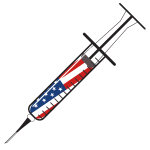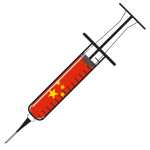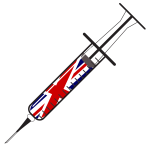How the US, UK, and China are planning to roll out vaccines
The vaccines are coming. The UK became the first country in the West to approve a covid-19 vaccine for emergency use on December 2, specifically the Pfizer and BioNTech vaccine, which has completed phase 3 trials. But the US, the EU, and many other countries are expected to follow suit in the following days and weeks. The imminent arrival of vaccines means that countries not only face a huge logistical challenge to distribute them-which is complicated by the fact the two most promising vaccines require ultra-cold temperatures-but also have to grapple with hard choices over who gets them first.
Here's how different countries are making their decisions on distributing vaccines to their populations.
United StatesHow many doses will be available? Up to 40 million doses are expected to be on offer in the US by the end of 2020-25 million of which will come from Pfizer-BioNTech and 12.5 million from Moderna, according to Reuters. Since the vaccines each require two doses spaced several weeks apart, this will be enough to vaccinate 20 million people-but not all shipments will come at once. The first shipment will reportedly cover 3.2 million people, with 5 to 10 million more doses delivered each week after that.

Who will get it first? In the US, individual states are responsible for creating their own vaccine distribution plans. They are meant to follow general guidance from the CDC's Interim Playbook for Covid-19, which was shaped by the Advisory Committee on Immunization Practices (ACIP) with input from the National Academies of Sciences, Engineering, and Medicine.
ACIP met on December 1 and voted on the recommended first phase of the distribution plan. This is known as 1a, and will prioritize 21 million health-care workers and 3 million adults in long-term care facilities, like nursing homes, who are particularly vulnerable.
The following phases will add other people to the list: 1b will prioritize other essential workers, such as school staff, while 1c prioritizes adults older than 65 and others with other medical issues that increase the risk of serious complications from covid.
Phase two would cover people who work in schools, transportation, housing facilities like nursing homes, and other places with high concentrations of people. Phase three includes young adults and children-in an attempt to stop superspreading events-as well as other essential workers not previously covered. Phase four would include everyone else.
But the CDC guidelines leave a lot for state and local governments to interpret and implement.
Even in phase 1, different states have different definitions for essential workers, for example. ACIP has yet to discuss anything beyond phase 1, leaving many open questions about how to prioritize the rest of the population. One analysis of 47 published state plans by the Kaiser Family Foundation found that about half explicitly mentioned race and health equity as a factor.
ChinaHow many doses will be available? Chinese scientists say the country will have 600 million doses ready this year, the South China Morning Post reports. Wang Junzhi, a member of the nation's vaccine task force, told journalists on December 4 that the doses of inactivated vaccines will be ready for launch before the end of the year. He said a major announcement"on vaccine trials was expected in the coming weeks.

China has five vaccine candidates from four manufacturers in phase 3 clinical trials, including the front-runners from Sinopharm and Sinovac Biotech. While none have yet been approved for commercial use, they have been administered in so-called pre-tests" in China, where coronavirus numbers are low, and are also undergoing phase 3 trials in 15 countries abroad.
Who will get it first? That question's already been answered. Emergency authorization was granted to the two leading candidates earlier this year. Since June, an unknown number of People's Liberation Army members have received shots, and essential city workers started getting vaccinated in July. All in all, roughly 1 million people have received emergency authorization vaccines so far, including employees of state-owned enterprises, Huawei employees in 180 countries, and Chinese diplomats.
An emergency-use authorization, which is based on Chinese vaccine management law, allows unapproved vaccine candidates to be used among people who are at high risk of getting infected on a limited period," said Zheng Zhongwei, the director of the Science and Technology Development Center of China's National Health Commission, in an interview with China's state television channel on August 22.
President Xi Jinping has vowed to make the vaccine available around the world as aglobal public good." In October, China joined the Covax Facility, a global alliance of 189 countries that have pledged to equitably distribute vaccines. The US is not part of that group.
The countries prioritized for distribution of the five Chinese vaccine candidates are primarily those that have hosted trials, which in turn is shaped by China's strategic interest. These include Brazil, Indonesia, and Turkey, which have signed deals for 46 million, 50 million, and 50 million Sinovac doses, respectively; and Mexico, which has a deal with CanSino Biologics for 35 million doses.
Little is known about how the Chinese government is prioritizing vaccine distribution domestically, though local reports suggest that individual provinces are making their own plans to buy vaccine doses, which will cost 200 RMB per dose (roughly $30.) The state insurance plan will not cover the cost.
UKHow many doses will be available? The UK approved the Pfizer-BioNTech vaccine for emergency use in the general public on December 2. It will start inoculating its population of 67 million people through the state-run National Health Service, with the first vaccinations to be given to the highest-priority individuals starting December 7. The UK bought 40 million doses of the Pfizer vaccine; each person requires two doses, so that is enough to vaccinate about a third of the population. It has also purchased 100 million doses of the AstraZeneca-Oxford vaccine, 7 million doses of the Moderna vaccine, and smaller quantities of other vaccine candidates, bringing the total to 355 million doses-in short, more than enough to vaccinate everyone.

Who will get it first? The UK's decision relied on a group called the Joint Committee on Vaccination and Immunisation (JCVI), an independent committee of academics and medical experts responsible for advising government ministers. For its phase 1 delivery, it divided the population into nine groups, recommended vaccinating them in this order of priority, which the government has adopted:
- Residents and staff working in elder-care homes
- Everyone over 80 years old plus health and social care workers
- Everyone over 75 years old
- Everyone over 70 years old plus clinically extremely vulnerable" individuals, which does not include pregnant people or those under the age of 18.
- Everyone over 65 years old
- Adults aged 18 to 65 years in an at-risk group. This includes people with chronic diseases, diabetes, learning difficulties, morbid obesity or severe mental illness.
- Everyone over 60 years old
- Everyone over 55 years old
- Everyone over 50 years old
The JCVI has publicly explained its thinking in a 25-page document stating that current evidence strongly indicates that the single greatest risk of mortality from covid-19 is increasing age." It has not yet announced plans beyond phase 1.
ElsewhereRussia: Russia became the first country anywhere to approve a vaccine back in August 2020. President Vladimir Putin himself announced that its Sputnik V vaccine had been granted authorization on August 11, before phase 3 trials had even started. Those are still under way, but the country is already preparing to start mass immunizations, with Putin ordering officials to start making the necessary preparations just hours after the news of the UK's approval came in. Vaccinations will reportedly begin with health-care workers and teachers. They will be free of charge, and the Kremlin says they will be carried out on a voluntary basis. Russia also says it will have up to 500 million doses ready for export.
Other countries: The options are limited for many lower- and middle-income countries, since the world's richest nations-including the 27 member-states of the EU as well as Canada, the United States, the United Kingdom, Australia, and Japan-have already pre-ordered half the world's expected available supply. Ninety-two of these countries have joined the Covax Facility, which has secured 700 million doses and aims to cover 20% of the population of lower- and middle-income countries by the end of 2021.